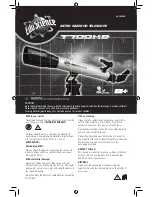
The equatorial mount is designed to move in any direction. It can be set to allow
manual controls to track the movements of celestial bodies across the sky. This
is referred to as diurnal movement; movement of celestial bodies in the direction
opposite to that of the earth’s rotation and is around the earth’s axis.
By aligning the telescope’s polar axis at celestial North, you will place the
telescope in parallel with the earth’s axis and thus be able to locate stars in the
sky based on star atlas information. To compensate for your position on earth,
the polar axis is set in one of three ways:
•
Set up the telescope at night. Loosen the declination axis lock screw (use
adjustment tool provided) and rotate the telescope around the declination
axis until the arrow on the declination scale points to 90 degrees. Tighten the
declination axis lock screw. The telescope is now roughly in parallel with the
polar axis.
•
Loosen the horizontal axis lock screw and turn the telescope until
the objective end faces due north. This can be done by
approximating the location of the pole star (Polaris or North Star)
or by the use of a compass. True North is then found by directing
the telescope at Polaris, as magnetic North is slightly away from
true North.
•
Look up the latitude of your area in any geographical atlas.
Loosen the latitude lock screw and set the latitude scale to the
correct latitude for your area. Aim the Finderscope at Polaris. You
will probably notice that Polaris is not dead center in the
finderscope’s field of view. This is probably because your
telescope is not absolutely level with the ground. Loosen the
horizontal axis lock screw again and turn the telescope so that it is directly aimed at Polaris. Tighten both
the horizontal axis lock screw and the Latitude Lock Screw. Polaris is 1 degree of the North celestial pole.
Therefore, the sighting of stars will have to be slightly adjusted as you locate them in the heavens.
IV.
TIPS FOR USING YOUR TELESCOPE
Focusing the Telescope
•
Aim the main telescope tube at a well-defined target, at least 200 yards away (e.g. a telephone pole or
building). Fully extend the focusing tube by turning the
rack and pinion focusing mechanism (16)
.
•
While looking through the
Eyepiece Lens (19)
, slowly retract focusing tube by turning the
rack and pinion
focusing mechanism
until object comes into focus.
(Note: The image will be upside down and reversed.
This is a normal occurrence in astronomical telescopes. )
Aligning the Finderscope
•
Locate an object at least 200 yards away. Tighten the
Latitude Lock Screw (fig 5.)
so that telescope’s aim
is not disturbed.
•
Looking through the
Finderscope (21)
, adjust the
Finderscope
Adjustment Screws (22)
until the crosshairs
of the
Finderscope
are precisely centered on the same object already centered in the field of view of the
Main Telescope Tube
.
(Note: image in finderscope will be upside down and reversed.)
•
Objects located using the finderscope will also be centered in the main telescope’s view.
Never Look Directly At The Sun With Your Telescope
Permanent Damage To Your Eyes May Occur
Balancing the Telescope
•
Arrange the telescope so that the telescope body is horizontal to the floor (latitude of 0
°
). Loosen the
Right Ascension Lock [Locks right ascension axis (15)]
. The telescope should now turn freely about the
Horizontal Axis
Lock Screw
Latitude Lock Screw























